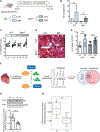Ibrutinib-Mediated Atrial Fibrillation Attributable to Inhibition of C-Terminal Src Kinase
- PMID: 33092403
- PMCID: PMC9661397
- DOI: 10.1161/CIRCULATIONAHA.120.049210
Ibrutinib-Mediated Atrial Fibrillation Attributable to Inhibition of C-Terminal Src Kinase
Abstract
Background: Ibrutinib is a Bruton tyrosine kinase inhibitor with remarkable efficacy against B-cell cancers. Ibrutinib also increases the risk of atrial fibrillation (AF), which remains poorly understood.
Methods: We performed electrophysiology studies on mice treated with ibrutinib to assess inducibility of AF. Chemoproteomic analysis of cardiac lysates identified candidate ibrutinib targets, which were further evaluated in genetic mouse models and additional pharmacological experiments. The pharmacovigilance database, VigiBase, was queried to determine whether drug inhibition of an identified candidate kinase was associated with increased reporting of AF.
Results: We demonstrate that treatment of mice with ibrutinib for 4 weeks results in inducible AF, left atrial enlargement, myocardial fibrosis, and inflammation. This effect was reproduced in mice lacking Bruton tyrosine kinase, but not in mice treated with 4 weeks of acalabrutinib, a more specific Bruton tyrosine kinase inhibitor, demonstrating that AF is an off-target side effect. Chemoproteomic profiling identified a short list of candidate kinases that was narrowed by additional experimentation leaving CSK (C-terminal Src kinase) as the strongest candidate for ibrutinib-induced AF. Cardiac-specific Csk knockout in mice led to increased AF, left atrial enlargement, fibrosis, and inflammation, phenocopying ibrutinib treatment. Disproportionality analyses in VigiBase confirmed increased reporting of AF associated with kinase inhibitors blocking Csk versus non-Csk inhibitors, with a reporting odds ratio of 8.0 (95% CI, 7.3-8.7; P<0.0001).
Conclusions: These data identify Csk inhibition as the mechanism through which ibrutinib leads to AF. Registration: URL: https://ww.clinicaltrials.gov; Unique identifier: NCT03530215.
Keywords: BTK protein, human; CSK tyrosine-protein kinase; atrial fibrillation; electrophysiology; ibrutinib; protein kinase inhibitors.
Figures




Comment in
-
Cardio-Oncology: A Win-Win Situation: How Solving the Mystery of an Ibrutinib Off-Target Effect Reveals New Insights Into Atrial Fibrillation Mechanisms.Circulation. 2020 Dec 22;142(25):2456-2458. doi: 10.1161/CIRCULATIONAHA.120.052047. Epub 2020 Dec 21. Circulation. 2020. PMID: 33347329 No abstract available.
References
-
- Brown JR, Moslehi J, O’Brien S, Ghia P, Hillmen P, Cymbalista F, Shanafelt TD, Fraser G, Rule S, Kipps TJ, et al. Characterization of atrial fibrillation adverse events reported in ibrutinib randomized controlled registration trials. Haematologica. 2017;102:1796–1805. doi: 10.3324/haematol.2017.171041 - DOI - PMC - PubMed
Publication types
MeSH terms
Substances
Associated data
Grants and funding
LinkOut - more resources
Full Text Sources
Medical
Molecular Biology Databases
Miscellaneous

